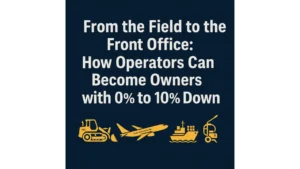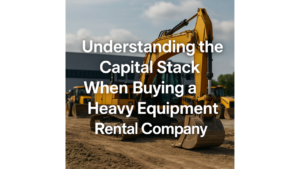Selling a heavy equipment rental company is not a casual transaction it’s the outcome of decades of operational discipline, capital deployment, and customer service. The exit process must match that same level of seriousness.
This article outlines the ideal M&A process that any owner of a heavy equipment rental company should follow when preparing to sell. It’s not a quick flip or a spreadsheet exercise. This is a multi-phase strategy built on preparation, negotiation, and proper positioning.
1. Define Intent: Know Why You’re Selling
Every successful sale starts with clarity. The owner must have a real reason to exit:
- Retirement
- Burnout or health
- No succession plan
- Reallocation of capital to other ventures
Trying to time the market is not a viable reason.
Without a real, emotionally grounded motive, sellers are likely to stall, hesitate, or withdraw during critical parts of the process.
2. Start With Confidentiality and Pre-Valuation
The first tactical step in the M&A process is to lock down confidentiality and establish a realistic valuation range. This begins by having potential advisors or buyers sign a Non-Disclosure Agreement (NDA) to protect financials, fleet data, and other proprietary details.
Once that’s in place, the seller should prepare and organize the following materials:
- 2–3 years of Profit & Loss (P&L) statements – These show historical performance, seasonality, margin consistency, and any one-time anomalies.
- Breakdown of rental vs. sales/service income – Buyers prioritize recurring rental income, which is valued more highly than one-off equipment sales or service labor.
- Fleet details – Including Original Equipment Cost (OEC), age of units, utilization rates, and dollar utilization trends. A newer, highly utilized fleet increases value.
With this data in hand, valuation is estimated using three common industry benchmarks:
- EBITDA multiple (5.0x–6.5x) – Based on earnings before interest, taxes, depreciation, and amortization. This reflects operational profitability and scale.
- Rental revenue multiple (~2.3x) – Applied only to recurring rental income. This is often used as a top-line proxy when EBITDA isn’t the focus.
- Fleet-based multiple (~1.5x OEC) – Buyers compare the fleet’s original cost to assess how much value remains in the physical assets.
Each valuation lens provides a different view of the business buyers will triangulate across all three. A quality deal process ensures the business is well-positioned under each metric.
Lastly, it’s essential to engage a tax advisor early to calculate net after-tax proceeds. Depending on whether the deal is structured as an asset sale or stock sale and how depreciation recapture, goodwill, and state-level tax issues are handled is the difference between headline price and what the seller keeps can be substantial.
This phase ensures the seller is protected, well-informed, and operating with clear expectations. It also lays the foundation for intelligent negotiation later in the process.
3. Engagement and Information Memorandum
If valuation expectations align, the seller should engage a qualified M&A advisor. That advisor will build a Confidential Information Memorandum (CIM) or investment packet detailing:
- Company history and operational model
- Fleet size, condition, and utilization metrics
- Dollar utilization trends
- Management structure and staff overview
- Seller’s planned post-close involvement
- Real estate status (owned vs. leased)
This document is the seller’s pitch deck it’s crafted to tell the right story to the right buyer.
4. Targeted Buyer Selection
The next step is selective outreach. The best processes do not involve mass-market listings. Instead, they identify 3–6 qualified buyers, often including:
- National strategics (e.g., United Rentals, Sunbelt, Herc)
- Private equity-backed consolidators with rental specialization
Each buyer should sign an NDA and receive the CIM only if they meet the target profile.
5. Conducting Management Meetings
An essential but often underappreciated step is the informal management meeting. These meetings are:
- Off-site, often over dinner
- Focused on cultural alignment
- Meant to allow both sides to assess fit and tone
This step builds trust and often determines whether an offer becomes a deal.
6. Negotiation and Letter of Intent (LOI)
After buyer interest is confirmed, the advisor should request Letters of Intent (LOIs). Key negotiation points include:
- Total purchase price
- Earnouts or contingent value based on performance
- Leaseback terms (if real estate is retained by seller)
- Compensation for the seller during transition
The seller must maintain leverage this is done through preparation and not needing to transact.
7. Due Diligence and Legal Documentation
Once the LOI is signed, due diligence begins. Buyers will request:
- Detailed payroll and employee agreements
- Equipment maintenance and usage history
- Contracts with customers and suppliers
- Insurance, licenses, and compliance documents
Simultaneously, attorneys draft:
- Asset Purchase Agreement (APA)
- Lease agreements
- Employment agreements for retained staff or the seller
A strong advisor will coordinate this phase to minimize delays and control costs.
8. HR Integration and Final Closing Steps
In the final days before closing:
- Seller announces the transaction internally
- Buyer’s HR team meets with employees
- Systems, benefits, and payroll are transitioned
Wire transfers and signatures finalize the deal. This is often the most emotional moment for the seller.
9. Transition Period Post-Close
The best deals include a structured post-close period:
- 6–24 months of continued involvement by the seller
- Defined responsibilities
- Compensation plan for the seller
This ensures continuity and stability for customers, staff, and the buyer.
10. What Sellers Should Do 1–3 Years Before Selling
To prepare for a successful exit, owners should:
- Modernize accounting and software systems
- Eliminate underutilized assets from the fleet
- Groom second-level management to reduce dependency on owner
- Track dollar utilization and fleet metrics proactively
- Address compliance or regulatory issues early
And most importantly start early. Exit planning should begin 24–36 months ahead of any expected sale.
Final Word
This is the ideal M&A process for selling a heavy equipment rental business. It honors what the owner has built, maximizes value, and ensures the transition is smooth for all stakeholders buyers, employees, and customers alike.
Owners who approach this process methodically and with proper advisory support will walk away with not only the best price but peace of mind.
Gustavo Lopez Founder, Strategic Solvers Helping capital-backed operators scale smarter with real infrastructure, real iron, and real systems.
#ExcavatorMasterSeries #BuyRepairRent #HeavyEquipmentCapital #StrategicSolvers #RentalMargin #CAT336 #AssetBackedOps #IronThatPays






